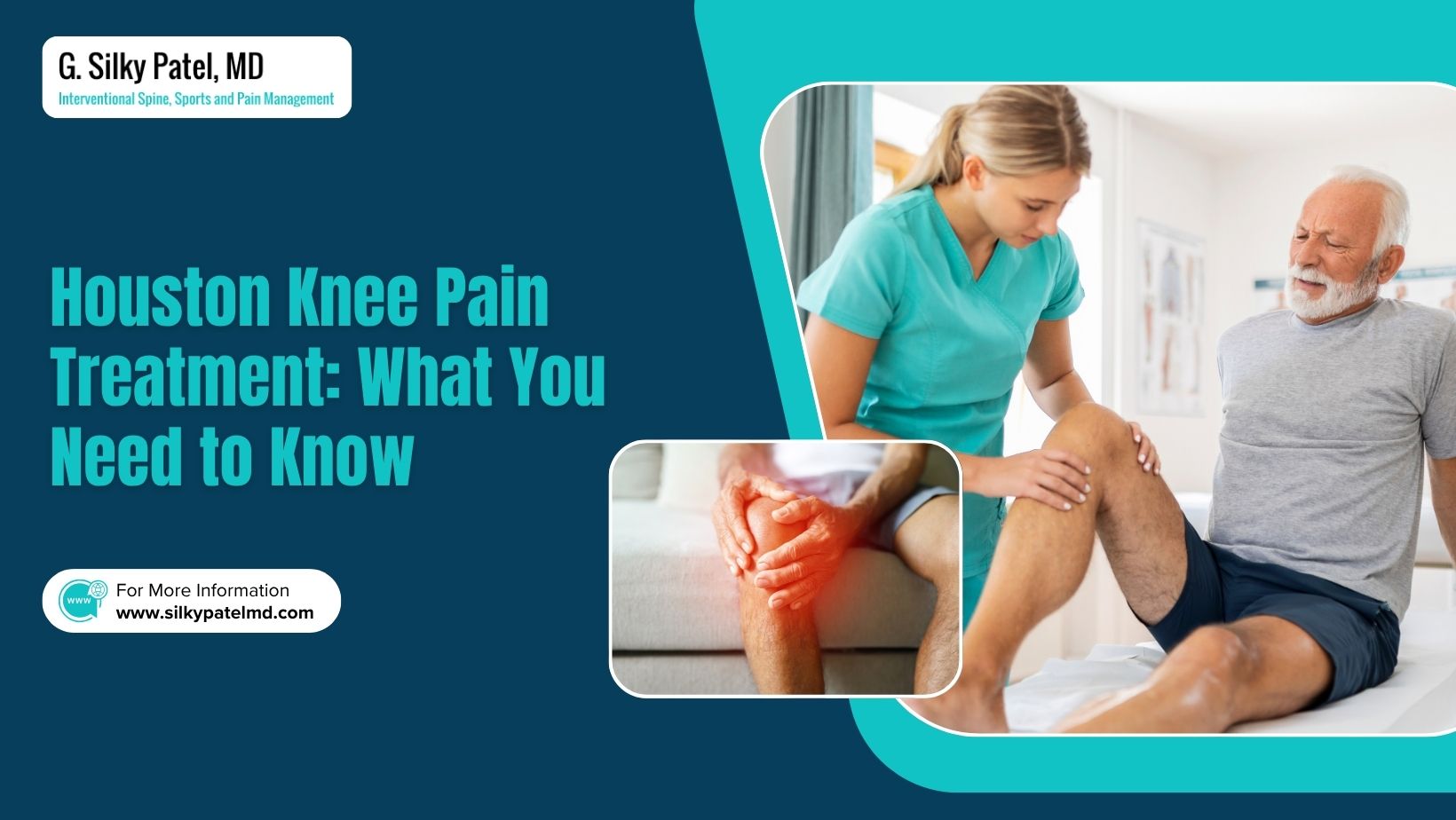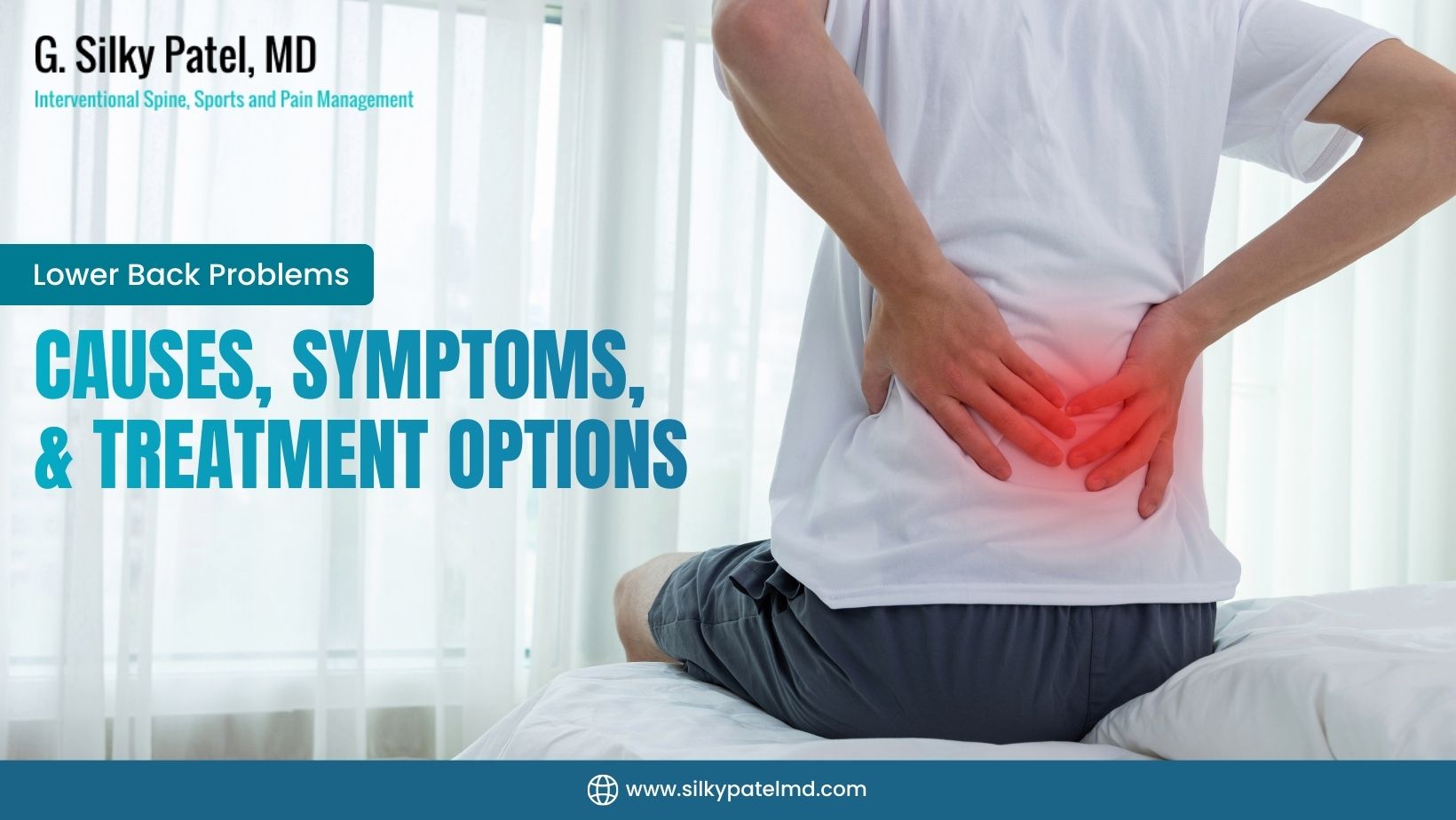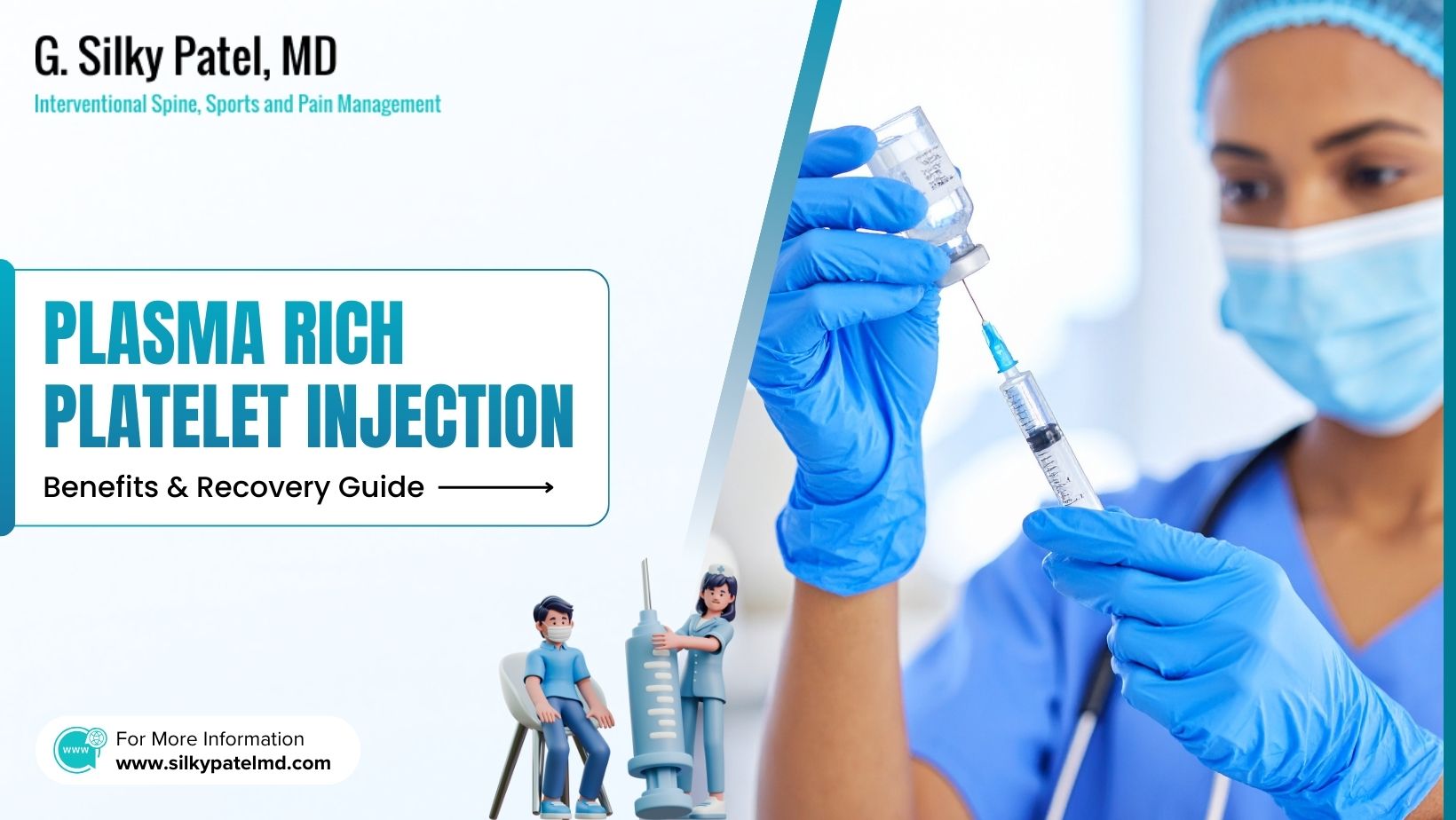Table of Contents
ToggleHouston knee pain treatment is the first step toward reclaiming your comfort, mobility, and active lifestyle in the Bayou City. Whether you’re navigating long shifts at the Texas Medical Center, spending weekends hiking in Memorial Park, or just trying to walk your dog around the Heights without a limp, knee pain can sneak in and take over. It often starts as a dull ache, then suddenly you’re avoiding stairs, skipping workouts, or waking up stiff every morning.
Living in Houston means living on your feet. The city’s walkable neighborhoods, sprawling suburbs, and year-round humidity place constant pressure on your joints—especially the knees. Pain in this area isn’t just physical; it can slow down your social life, impact your work, and weigh on your mental health. That’s why seeking expert care from someone who understands the lifestyle and demands of this city is so important.
Dr. Silky Patel offers a science-driven, empathetic approach to Houston knee pain treatment. She doesn’t just mask symptoms—she listens closely, looks deeply, and delivers care that’s designed around your specific pain patterns and movement goals. Her specialized knowledge and commitment to the Houston community make her a trusted partner for long-term joint health.
Houston Knee Pain Treatment: Understanding Your Knee Troubles
Before treatment comes understanding. The knee is a powerhouse joint—it carries most of your body weight, stabilizes your movements, and absorbs impact every time you sit, stand, or take a step. In a fast-paced city like Houston, it’s no wonder knees often bear the brunt of our lifestyles. Effective Houston knee pain treatment starts by identifying what’s going wrong beneath the surface.
Anatomy of Knee Pain
Your knee is made up of three bones—the femur, tibia, and patella—held together by a web of cartilage, ligaments, tendons, and fluid-filled sacs called bursae. When everything’s working together, the knee glides effortlessly. But when even one component falters, the result can be stiffness, swelling, or grinding pain.
Most Common Knee Conditions in Houston
In Dr. Patel’s experience, Houston knee pain treatment often centers around a handful of repeat offenders—some mechanical, some inflammatory, and others rooted in long-term wear and tear.
Osteoarthritis
This is the slow-burning fire behind many chronic knee pain cases. Osteoarthritis breaks down the cartilage that cushions your knee, causing bones to rub directly against one another. It’s especially common among Houston’s aging adults or those with active, high-impact lifestyles.
Overuse Injuries
Knee pain doesn’t always come from one big accident. For many in Houston, it’s the result of doing a little too much, a little too often. Whether you’re a Rice Village jogger, a CrossFit enthusiast in Midtown, or someone who kneels often for work, repetitive stress can lead to tendonitis, IT band syndrome, or bursitis.
Ligament Sprains and Tears
These injuries often happen in an instant—a bad pivot on the soccer field, an awkward landing after a fall, or a misstep on uneven pavement in Montrose. Torn ACLs, strained MCLs, and other ligament injuries are common among both athletes and weekend warriors seeking Houston knee pain treatment.
Meniscus Damage
The meniscus is a rubbery cartilage that acts as a shock absorber. A tear here, whether from aging or sudden trauma, can make even basic movement painful. Houston’s active lifestyle makes meniscus injuries surprisingly frequent among all age groups.
Inflammatory Conditions
Autoimmune disorders like rheumatoid arthritis and gout don’t just affect internal systems—they target the joints, especially the knees. These conditions cause painful flare-ups and require long-term, tailored Houston knee pain treatment to prevent joint damage and reduce systemic inflammation.
Diagnosis: How Dr. Patel Pinpoints the Root Cause
Not all knee pain is created equal, which is why a clear diagnosis is the foundation of effective Houston knee pain treatment. Dr. Silky Patel doesn’t rely on guesswork—she uses a step-by-step approach to understand the source of your pain and how it behaves under pressure, motion, and rest.
Initial Consultation and History
Your story matters. Dr. Patel begins by asking about the onset of pain, what worsens it, how it impacts your day, and whether you’ve had any injuries. Each response helps guide a tailored Houston knee pain treatment strategy. She digs deep to uncover patterns—did the pain come on suddenly or gradually? Is it worse in the morning or after activity? Every detail shapes her diagnostic path.
Physical Examination
Dr. Patel then performs a detailed physical exam, evaluating your gait, flexibility, swelling, joint warmth, and strength. She gently manipulates the knee to test for instability, grinding, or locking—all of which point to specific conditions that shape a targeted Houston knee pain treatment approach. Her hands-on assessment allows her to spot mechanical issues that imaging might miss.
Imaging and Diagnostic Tests
Modern tools offer a window into the joint without making a single incision. Dr. Patel selects only the tests you truly need—ensuring efficiency without sacrificing accuracy.
X-Rays
Used to check for bone damage, narrowing of the joint space, and signs of osteoarthritis, X-rays provide an essential first look.
MRI Scans
An MRI offers a deeper dive into the knee’s soft tissues. It’s the gold standard for spotting meniscus tears, ligament injuries, and cartilage damage.
Ultrasound
This fast, non-invasive test is ideal for evaluating bursitis, tendonitis, or fluid buildup. Dr. Patel uses ultrasound in-office to monitor inflammation and guide certain injection treatments.
Joint Aspiration and Lab Work
When swelling is present, Dr. Patel may draw fluid from the knee for testing. This can confirm conditions like gout, infection, or autoimmune flare-ups. Blood tests may also be ordered to check inflammatory markers or rule out underlying diseases.
Non-Surgical Solutions Right Here in Houston
Dr. Silky Patel approaches non-surgical care with the expertise of someone who’s led at the highest levels. She has treated thousands of Houstonians and previously held positions as Clinical Assistant Professor of Neurosurgery at UT–Houston Medical School and Director of Pain Management at Houston Methodist West Hospital. Her focus remains on creating personalized, evidence-based treatment paths for lasting relief.
Non-surgical care remains the foundation of effective Houston knee pain treatment for most patients. These approaches focus on reducing inflammation, supporting the joint, and retraining movement to minimize pressure on sensitive tissues. When tailored properly, conservative care can dramatically reduce pain and restore daily function—without the risks or recovery time that come with surgery.
Lifestyle Adjustments That Reduce Strain
Dr. Silky Patel often begins treatment by examining the habits and environments that contribute to knee discomfort. In a city like Houston, where people spend long hours commuting, walking on concrete, and engaging in outdoor activities, subtle changes in routine can dramatically support the effectiveness of Houston knee pain treatment.
Weight Management
Excess weight increases the force across the knee with every step. In fact, even ten extra pounds can translate into fifty additional pounds of pressure on your knees. For patients in Houston struggling with knee pain, weight loss is often one of the most impactful components of care. Dr. Patel works with patients to set realistic, joint-friendly goals that reduce inflammation and improve mobility.
Activity Modification
Sometimes it’s not about stopping activity—but doing it differently. Dr. Patel helps patients swap high-impact sports for joint-safe alternatives. Houston offers plenty of low-impact options like water aerobics, stationary cycling, and walking paths with softer terrain in areas like Terry Hershey Park. These changes help you stay active while giving the knee a break.
Physical Therapy and Guided Rehabilitation
A key part of Houston knee pain treatment is restoring strength and alignment. When muscles around the knee are weak or imbalanced, they fail to support the joint effectively. This leads to strain on ligaments, cartilage, and other internal structures.
Targeted Strengthening
Dr. Patel collaborates with local physical therapists to build customized programs that strengthen the quadriceps, hamstrings, glutes, and calves. These muscles form the foundation of knee support. As strength improves, pain often subsides.
Flexibility and Balance Training
Tight hip flexors, limited ankle motion, or poor balance can all shift extra load onto the knee. A good rehab plan addresses the full kinetic chain. Stretching and coordination drills are used to restore fluid, pain-free motion.
Supportive Devices for Joint Protection
Knees need stability to heal. For many Houstonians, simple support devices can reduce pain significantly and allow healing to occur more effectively when used as part of a broader Houston knee pain treatment plan.
Bracing
Whether it’s a compression sleeve or a hinged brace, external support gives your knee the backup it needs. Dr. Patel carefully selects the right brace based on your symptoms and activity level—ensuring maximum benefit without over-reliance.
Orthotics
Foot structure affects the knee. If flat feet, overpronation, or poor shoe support are part of the problem, Dr. Patel may recommend orthotic inserts to correct alignment. This reduces torque on the knee and can ease pain from conditions like patellofemoral syndrome or tendonitis.
Over-the-Counter Medications and Topical Treatments
Short-term relief can come from simple tools already available at your local pharmacy. While these are not long-term solutions on their own, they can help you stay functional while deeper healing occurs through a guided Houston knee pain treatment regimen.
Oral Pain Relievers
Nonsteroidal anti-inflammatory drugs (NSAIDs) like ibuprofen and naproxen work well to reduce inflammation and provide temporary comfort. For patients unable to take NSAIDs, acetaminophen (such as Tylenol) may be a suitable alternative.
Topical Creams
Topical analgesics containing menthol, capsaicin, or lidocaine can numb surface-level discomfort. Dr. Patel often recommends these during flare-ups or when deeper interventions are not immediately available.
In-Office Advanced Therapies with Dr. Silky Patel
When home care and physical therapy aren’t enough, advanced medical interventions can bridge the gap between chronic pain and restored motion. Dr. Silky Patel provides a range of minimally invasive procedures as part of comprehensive Houston knee pain treatment. These therapies are designed to interrupt the pain cycle, reduce inflammation, and restore joint function with little to no downtime.
Corticosteroid Injections
One of the most commonly used in-office treatments, corticosteroid injections deliver powerful anti-inflammatory medication directly into the joint space. Relief is often rapid, lasting anywhere from several weeks to a few months. These are especially helpful for patients managing osteoarthritis flare-ups or acute bursitis.
Hyaluronic Acid Injections
In cases of cartilage wear and joint fluid thinning, hyaluronic acid can be injected to improve lubrication and cushioning. Often referred to as “viscosupplementation,” this therapy mimics the natural fluid in your knee and is frequently included in non-surgical Houston knee pain treatment plans. It’s ideal for patients who want longer-term comfort without undergoing surgery. Results vary, but many experience smoother motion and reduced stiffness within weeks.
Platelet-Rich Plasma (PRP)
This cutting-edge treatment uses your own blood to promote healing. Dr. Patel draws a small amount of blood, spins it in a centrifuge, and injects the concentrated platelets into the injured area. The goal is to activate your body’s own repair process—particularly for tendon injuries, ligament sprains, or early cartilage breakdown. PRP is gaining popularity in Houston among patients seeking natural, regenerative approaches.
Genicular Nerve Block
For patients with persistent pain that hasn’t responded to other therapies, a genicular nerve block may be an option. This procedure involves numbing the sensory nerves around the knee to interrupt pain signals and is occasionally used during advanced stages of Houston knee pain treatment as a diagnostic and therapeutic tool.
Joint Aspiration
In cases of visible swelling, Dr. Patel may perform a joint aspiration, or arthrocentesis, to remove excess fluid. This relieves pressure, reduces pain, and allows for diagnostic testing of the fluid itself. It’s a quick procedure done right in the office, offering fast results.
Ultrasound-Guided Procedures
To ensure accuracy and minimize risk, Dr. Patel uses ultrasound guidance for many of her injection-based treatments. This technology allows her to place medication exactly where it’s needed—no guesswork, just precision and safety.
When Surgery Becomes an Option
For many patients in Houston, knee pain starts off mild and manageable—but sometimes, even the most advanced non-surgical treatments may not provide lasting relief. When this happens, surgical intervention becomes part of the broader conversation. While surgery is never the first step in Houston knee pain treatment, it can be a necessary one when joint damage is severe, mechanical function is lost, or daily life is consistently disrupted.
Signs That Surgery Might Be Needed
Dr. Silky Patel evaluates every patient’s progress based on symptoms, imaging results, and functional goals. Surgery is usually considered when other aspects of Houston knee pain treatment have not restored adequate mobility or when quality of life is significantly impacted.
Persistent Pain
If knee pain continues despite months of physical therapy, medications, and injection therapy, it’s time to re-evaluate. Ongoing discomfort that interferes with walking, standing, or sleeping may indicate deeper structural damage that needs surgical correction.
Mechanical Symptoms
Clicking, catching, or locking of the knee can point to cartilage tears or loose bone fragments. These mechanical issues may not improve with rehabilitation alone. When function is compromised this way, surgical intervention becomes a targeted solution within the scope of comprehensive Houston knee pain treatment.
Severe Joint Damage
Conditions like advanced osteoarthritis or rheumatoid arthritis can degrade joint surfaces beyond repair. In these cases, imaging often shows bone-on-bone contact or total loss of cartilage, making joint replacement surgery the most effective path forward.
Types of Knee Surgery
If surgery is required, Dr. Patel works closely with Houston’s top orthopedic surgeons to coordinate care and ensure a seamless experience. Her involvement continues throughout recovery as part of comprehensive Houston knee pain treatment to optimize long-term outcomes.
Arthroscopy
This minimally invasive procedure allows a surgeon to access the joint through tiny incisions. Using a camera and specialized instruments, damaged cartilage can be smoothed, torn meniscus fragments can be removed, and ligaments can be assessed. Arthroscopy is often performed for patients with localized damage who are still active and mobile.
Partial Knee Replacement
For patients with damage confined to a single part of the knee, a partial knee replacement may be a solution. This procedure replaces only the worn-out area, preserving healthy bone and ligaments. It’s less invasive than total replacement and typically offers quicker recovery when included in a structured Houston knee pain treatment continuum.
Total Knee Replacement
When joint damage is widespread, a total knee replacement may be necessary. This procedure involves replacing the entire joint surface with durable implants designed to restore function and eliminate pain. Dr. Patel helps patients prepare physically and emotionally for this step and remains involved in post-operative recovery planning.
Recovery and Preventing Future Knee Pain
Surgery or not, lasting relief requires a long-term mindset. Houston knee pain treatment doesn’t end after the last injection or final therapy session. In fact, the recovery phase is where transformation truly begins. This period is crucial for restoring movement, preventing setbacks, and protecting the knee from future injury.
The Recovery Process with Dr. Silky Patel
Dr. Patel supports patients through every step of their recovery, whether they’ve had surgery or achieved relief through non-invasive treatments. Her recovery plans are personalized, structured, and designed to meet your physical needs and lifestyle demands in Houston as part of complete Houston knee pain treatment.
Post-Treatment Rehabilitation
A strong recovery starts with movement. Early-stage rehab often focuses on regaining joint mobility, reducing swelling, and preventing stiffness. This may involve gentle exercises, supervised therapy sessions, and movement retraining to restore normal gait and muscle balance.
Strength and Conditioning
As healing progresses, Dr. Patel incorporates strength-building protocols to protect the knee from future strain. These programs often target the glutes, hamstrings, quads, and core—muscle groups that directly support knee health.
Neuromuscular Re-education
Sometimes, knee pain changes the way you move—leading to compensations that cause new problems down the road. Dr. Patel addresses these patterns with targeted drills that retrain the brain-body connection and prevent further injury.
Long-Term Strategies for Knee Protection
Recovery is only complete when prevention is in place. Dr. Patel helps patients adopt sustainable habits that reduce stress on the knees and keep them strong well into the future. This is a core component of effective Houston knee pain treatment and long-term joint wellness.
Footwear and Orthotic Support
Wearing shoes with adequate cushioning and arch support is critical, especially when walking on hard surfaces common in Houston’s urban landscape. In some cases, custom orthotics may be necessary to correct gait mechanics and offload pressure from sensitive areas.
Cross-Training and Low-Impact Exercise
Replacing repetitive, high-impact routines with varied, joint-friendly activity reduces the wear on your knees over time. Dr. Patel often recommends swimming, yoga, cycling, or elliptical training to keep the joints moving without causing harm.
Weight Stabilization and Anti-Inflammatory Nutrition
Maintaining a healthy weight is a protective factor for knee longevity. Dr. Patel also discusses dietary choices that support anti-inflammatory healing—lean proteins, omega-3 fats, colorful vegetables, and plenty of hydration.
A Note from Dr. Silky Patel
If you’ve made it this far, chances are you’re tired of wondering whether your knee pain is something you just have to live with. Let me tell you—it’s not. My commitment to Houston knee pain treatment isn’t just professional. It’s personal. I’ve seen how debilitating joint pain can be, how it changes how you move, how you sleep, and even how you feel about yourself.
I want you to know that you’re not alone in this. Whether your pain began with a sports injury, daily wear and tear, or something deeper, there’s always a way forward. Together, we’ll uncover the cause of your discomfort and create a treatment plan that fits your lifestyle and respects your goals. For some, that means gentle rehabilitation. For others, it may involve advanced in-office therapies or long-term joint protection strategies.
No two patients are alike, and neither are their knees. That’s why I approach every case of knee pain with fresh eyes, up-to-date knowledge, and a commitment to evidence-based care. Houston knee pain treatment should never feel like guesswork or a one-size-fits-all process—it should feel like progress. If you’re ready to take that next step, I’m here when you are.




